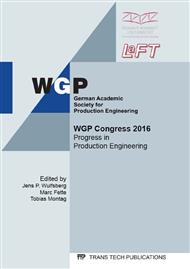[1]
Roland Berger Strategy Consultants, Mastering product complexity, Hamburg, (2012).
Google Scholar
[2]
Schuh, G., Potente, T., Thomas, C., Hausberg, C., Restructuring of production vs. continuous improvement processes - how to increase production performance, 24th Annual POM Conference Denver, Colorado, USA May 3–6 (2013).
Google Scholar
[3]
M. Jahangirian, T. Eldabi, A. Naseer, L. Stergioulas, T. Young, Simulation in manufacturing and business: A review, European Journal of Operational Research 203 (2010) 1-13.
DOI: 10.1016/j.ejor.2009.06.004
Google Scholar
[4]
H. Wilf, Generatingfunctionology, Academic Press, Boston, (1994).
Google Scholar
[5]
H.P. Wiendahl, J. Reicherardt, P. Nyhuis, Handbook Factory Planning and Design, Springer, Berlin, (2015).
Google Scholar
[6]
A. Ballakur, H.J. Steudel, A within-cell based heuristic for designing cellular manufacturing systems, International Journal of Production Research 25 (1987).
DOI: 10.1080/00207548708919868
Google Scholar
[7]
A. Karmani, H. Parssei, M. Chaudhry, A Survey of Design Methods for Manufacturing Cells, Computers and Industrial Engineering Vol. 25 (1993) 487-490.
Google Scholar
[8]
Y. Yin, K. Yasuda, Formation of manufacturing cells based on material flows, International Journal of Advances Manufacturing Technology 27 (2005) 159-165.
DOI: 10.1007/s00170-004-2143-2
Google Scholar
[9]
M. Ossama, A.M.A. Youssef, M.A. Shalaby, A multi-period cell formation model for reconfigurable manufacturing systems, Variety Management in Manufacturing – Proceedings of the 47th CIRP Conference on Manufacturing Systems 17 (2014) 130-135.
DOI: 10.1016/j.procir.2014.01.120
Google Scholar
[10]
G. Papaioannou, J. M. Wilson: The evolution of cell formation problem methodologies based on recent studies (1997–2008): Review and directions for future research, European Journal of Operational Research 206 (2010) 509-521.
DOI: 10.1016/j.ejor.2009.10.020
Google Scholar
[11]
R. Kia, H. Shirazi, N. Javadian, R. Tavakkoli-Moghaddan: A multi-objective model for designing a group layout of a dynamic cellular manufacturing system, Journal of Industrial Engineering Internation 53 (2013) 3390-3418.
DOI: 10.1186/2251-712x-9-8
Google Scholar
[12]
A.M. Golmohammadi, H. Bani-Asadi, H. Esmaeeli, H. Hadian, F. Bagheri, Facility layout for cellular manufacturing system unter dynamic conditions, Decision Science Letters5 (2016), 407-416.
DOI: 10.5267/j.dsl.2016.2.001
Google Scholar
[13]
T. Ghosh, P. K. Dan, S. Sengupta, M. Chattopadhyay, Genetic rule based techniques in cellular manufacturing (1992-2010): a systematic survey, International Journal of Engineering, Science and Technologie, Vol. 2, No. 5 (2010) 198-215.
DOI: 10.4314/ijest.v2i5.60148
Google Scholar
[14]
R. E. Thebeau, Klowledge Management of System Interfaces and Interactions for Product Development Process, Master's Thesis at Massachusetts Institute of Technology, System Design & Management Program, (2001).
Google Scholar
[15]
F. Borjesson, K. Hölttä-Otto, Improved Clustering Algorithm for Design Sturcture Matrix, Proceedings of the ASME 2012 IDETC/CIE, Chicago, Illinois, August 12-15, (2012).
DOI: 10.1115/detc2012-70076
Google Scholar


